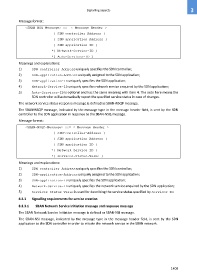Page 1419 - 5G Basics - Core Network Aspects
P. 1419
Signalling aspects 3
Message format:
<SBAN-NSQ-Message> ::= < Message Header >
{ SDN-controller-Address }
{ SDN-application-Address }
{ SDN-application-ID }
*{ Network-Service-ID }
*[ Auto-Services-ID ]
Meanings and explanations:
1) SDN-controller-Address uniquely specifies the SDN controller;
2) SDN-application-Address uniquely assigned to the SDN application;
3) SDN-application-ID uniquely specifies the SDN application;
4) Network-Service-ID uniquely specifies network service enquired by the SDN application;
5) Auto-Services-ID is optional and has the same meaning with item 4. The auto here means the
SDN controller will automatically report the specified service status in case of changes.
The network service status response message is defined as SBAN-NSQP message.
The SBAN-NSQP message, indicated by the message type in the message header field, is sent by the SDN
controller to the SDN application in response to the SBAN-NSQ message.
Message format:
<SBAN-NSQP-Message> ::= < Message Header >
{ SDN-controller-Address }
{ SDN-application-Address }
{ SDN-application-ID }
*{ Network-Service-ID }
*{ Services-Status-Value }
Meanings and explanations:
1) SDN-controller-Address uniquely specifies the SDN controller;
2) SDN-application-Address uniquely assigned to the SDN application;
3) SDN-application-ID uniquely specifies the SDN application;
4) Network-Service-ID uniquely specifies the network service enquired by the SDN application;
5) Services-Status-Value is used for describing the service status specified by Services-ID.
8.3.3 Signalling requirements for service creation
8.3.3.1 SBAN Network Service Initiation message and response message
The SBAN Network Service Initiation message is defined as SBAN-NSI message.
The SBAN-NSI message, indicated by the message type in the message header field, is sent by the SDN
application to the SDN controller in order to initiate the network service in the SBAN network.
1409

